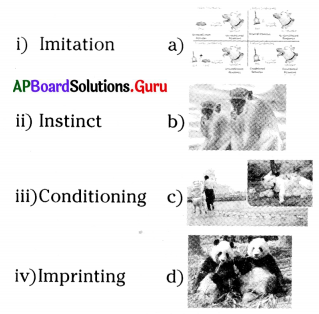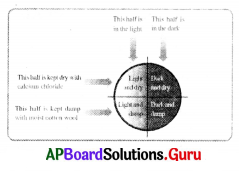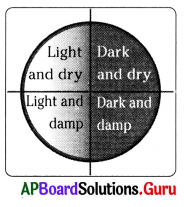Practice the AP 9th Class Biology Bits with Answers Chapter 7 Animal Behaviour on a regular basis so that you can attempt exams with utmost confidence.
AP State Syllabus 9th Class Biology Bits 7th Lesson Animal Behaviour with Answers
I. Choose the correct answers :
Question 1.
Animal behaviour indicates
A) How animals find and defend resources
B) How animals relate to their physical environment
C) Avoid predators, choose mates, reproduce
D) All the above
Answer:
D) All the above
Question 2.
This influence animal behaviour.
A) Animal physiology
B) Anatomy
C) Both A and B
D) None
Answer:
C) Both A and B
![]()
Question 3.
These are inborn behaviours.
A) Instinct
B) Imprinting
C) Conditioning
D) Imitation
Answer:
A) Instinct
Question 4.
These are examples for instinct behaviour.
A) Making nests by birds
B) Choose mates
C) Forming into groups for protection
D) All the above
Answer:
D) All the above
Question 5.
Reflexes are this type of behaviour.
A) Imitation
B) Instinct
C) Conditioning
D) Imprinting
Answer:
B) Instinct
Question 6.
Chickens and ducklings recognise their mother because of a behaviour called
A) Imitation
B) Conditioning
C) Imprinting
D) Instinct
Answer:
C) Imprinting
Question 7.
Students showing different types of behaviour to a school bell as per the time is
A) Conditioning
B) Imitation
C) Imprinting
D) Instinct
Answer:
A) Conditioning
Question 8.
The scientist that conducted experiments on conditioning is
A) Kohler
B) Ivan Pavlov
C) Ervin Pepperberg
D) Hermon
Answer:
B) Ivan Pavlov
Question 9.
Examples for conditioned reflexes are
A) Standing when elder people comes.
B) Standing attention on hearing national anthem.
C) When the school bell rings in the morning students gather for assembly.
D) All the above
Answer:
D) All the above
![]()
Question 10.
The scientist who observed imitation in chimpanzees ?
A) Kohler
B) Hermon
C) Pepperberg
D) Pavlov
Answer:
A) Kohler
Question 11.
Hungry persons want to eat immediately when they sit at the dining table but waits until everyone is seated and ready to eat because
A) Imitation
B) Instinct
C) Conditioning
D) Imprinting
Answer:
B) Instinct
Question 12.
By associating the product with attractive images the advertisers are trying to setup a response to their product with
A) Imitation
B) Instinct
C) Conditioning
D) Imprinting
Answer:
C) Conditioning
Question 13.
Scientists follow the journeys made by the animals using
A) Tagging
B) Enquiry
C) Both A and B
D) Signals
Answer:
A) Tagging
Question 14.
Searching and communicating nature of ants is because of
A) Hormones
B) Pheromones
C) Enzymes
D) All the above
Answer:
B) Pheromones
Question 15.
The insect that lay its eggs on the food material is
A) Wasp
B) Weaver bird
C) Ants
D) Cockroach
Answer:
A) Wasp
Question 16.
Which animal has great logical thinking power ?
A) Beaver
B) Dolphin
C) Squirrel
D) Scrubjay
Answer:
B) Dolphin
![]()
Question 17.
Parrot Alex called apple as
A) Bannery
B) Cherry
C) Banana
D) Orange
Answer:
A) Bannery
Question 18.
This animal releases bad smell to protect from predators.
A) Tasmanian Devil
B) Bombardier Beetle
C) Both A and B
D) Beaver
Answer:
B) Bombardier Beetle
Question 19.
It is the scientific and objective study of animal behaviour.
A) Ecology
B) Ornithology
C) Ethology
D) Anology
Answer:
C) Ethology
Question 20.
This scientist got Nobel prize for his work on animal behaviour in 1973.
A) Konard Lorenz
B) Nikolas Timbergen
C) Karlvon Frisch
D) All the above
Answer:
D) All the above
Question 21.
This helps in learning new skills.
A) Instinct
B) Imitation
C) Conditioning
D) None
Answer:
B) Imitation
Question 22.
Who among the following, got Nobel Prize in Ethology ?
A) Timbergen
B) Konard Lorenz
C) Karlvon Frisch
D) All the above
Answer:
D) All the above
Question 23.
This helps in getting discipline among the students.
A) Imitation
B) Instinct
C) Conditioning
D) All the above
Answer:
C) Conditioning
![]()
Question 24.
The worst smelling animal in the animal kingdom
A) Kangaroo
B) Spider
C) Chimpanzee
D) Tasmanian Devil
Answer:
D) Tasmanian Devil
Question 25.
Circus animals do so many feats in the circus. This is possible by
A) Instincts
B) Imitations
C) Conditioning
D) Imprinting
Answer:
C) Conditioning
Question 26.
‘Food stealing bird’ is ……………….
A) Peacock
B) Swift
C) Humming bird
D) Scrubjay bird
Answer:
D) Scrubjay bird
Question 27.
This animal build a dam by big trees.
A) Tasmanian Devil
B) Beaver
C) Squirrel
D) Alex
Answer:
B) Beaver
Question 28.
Reflexes are also examples for
A) Imitation
B) Imprinting
C) Conditioning
D) Instinct
Answer:
D) Instinct
Question 29.
Ducklings will follow the first moving object and treat it as their mother. This is an example for
A) Instinct
B) Imprinting
C) Conditioning
D) Reflex
Answer:
B) Imprinting
Question 30.
Cockroaches prefer the following condition
A) Light and dry
B) Dark and dry
C) Light and damp
D) Dark and damp
Answer:
D) Dark and damp
![]()
Question 31.
What type of behaviour involves in response to stimulus ?
A) Instinct
B) Imprinting
C) Conditioning
D) Imitation
Answer:
C) Conditioning
Question 32.
What type of behaviour is responsible for ducklings identifying their mother ?
A) Instinct
B) Conditioning
C) Imitation
D) Imprinting
Answer:
D) Imprinting
Question 33.
This bird builds it’s nest by three broad leaves.
A) Sparrow
B) Tailor Bird
C) Weaver Bird
D) Crow
Answer:
C) Weaver Bird
Question 34.
Identifying and smelling ability in dogs is due to
A) Enzymes
B) Hormones
C) Pheramones
D) Medicines
Answer:
C) Pheramones
Question 35.
Ivan Pavlov belongs to the following country.
A) Austria
B) Australia
C) Russia
D) South Africa
Answer:
C) Russia
Question 36.
Conditioning is an ……………….
A) Imprinting
B) Instinct Behaviour
C) Learned Behaviour
D) All of the above
Answer:
C) Learned Behaviour
Question 37.
Which of the following is not an instinct behaviour ?
A) Spinning of web by a spider
B) Smelling ability of dogs
C) Swimming by fish
D) None of the above
Answer:
D) None of the above
![]()
Question 38.
Migration of birds is an example of –
A) Imitation
B) Instinct
C) Imprinting
D) Conditioning
Answer:
B) Instinct
Question 39.
Konard Lorenz received Nobel Prize in the year
A) 1972
B) 1973
C) 1974
D) 1975
Answer:
D) 1975
Question 40.
Moving of bull towards plough when we untie the neck out of the pole is an example for ………………….
A) Instinct
B) Imitation
C) Conditioning
D) Reflex
Answer:
C) Conditioning
Question 41.
This is an example of harmful imitation among adolescent children.
A) Singing
B) Dancing
C) Acting
D) Smoking
Answer:
D) Smoking
Question 42.
Identify the mismatched pair from the following.
1) Training to parrot – Pepper Berg
2) Experiments on Chimpanzee – Pavlov
3) Condition experiments on dog – Kohler
A) 1 only
B) 1, 2
C) 2, 3
D) 3 only
Answer:
C) 2, 3
Question 43.
Read the following statements carefully.
a) Konard Lorenz conducted experiments on imprinting
b) A spider spinning its web is an example for imitation.
A) Both a, b incorrect
B) Both a, b correct
C) b correct, a incorrect
D) a correct, b incorrect
Answer:
D) a correct, b incorrect
Question 44.
Identify the correct matching from the following.

A) (i) – d (ii) – c (iii) – b (iv) – a
B) (i) – a, (ii) – d, (iii) – c, (iv) – b
C) (i) – b, (ii) – a, (iii) – c, (iv) – d
D) (i) – b, (ii) – d, (iii) – a, (iv) – c
Answer:
D) (i) – b, (ii) – d, (iii) – a, (iv) – c
![]()
Question 45.
Choose the correct matching from the following.
List – A
1) Instinct
2) Imprinting
3) Imitation
List – B
a) Recognising mother by child
b) Copying one by another
c) Inborn behaviour
A) 1 – c, 2 – b, 3 – a
B) 1 – a, 2 – c, 3 – b
C) 1 – b, 2 – a, 3 – c
D) 1 – c, 2 – b, 3 – a
Answer:
D) 1 -c, 2 – b, 3 – a
Question 46.
Identify the correct matching from the following.
List – A
1) Konard Lorenz
2) Copying the behaviour
3) Studying about animal behaviour
List – B
a) Imitation
b) Ethology
c) Imprinting
A) 1 – c, 2 – b, 3 – a
B) 1 – b, 2 – c, 3 – a
C) 1 – a, 2 – b, 3 – c
D) 1 – c, 2 – a, 3 – b
Answer:
D) 1 – c, 2 – a, 3 – b
II. Match the following:
1.
| Group A | Group B |
| 1) Instinct | A) Learned behaviour |
| 2) Imprinting | B) Saves from dangerous situations |
| 3) Conditioning | C) Inborn behaviour |
| 4) Imitation | D) Recognising mother by chickens |
| 5) Reflex actions | E) One animal copies another animal |
| F) Make us pain | |
| G) Behaviour in oldage |
Answer:
1) Instinct – C) Inborn behaviour
2) Imprinting – D) Recognising mother by chickens
3) Conditioning – A) Learned behaviour
4) Imitation – E) One animal copies another animal
5) Reflex actions – B) Saves from dangerous situations
2.
| Group A | Group B |
| 1) Imitation experiments in chimpanzees | A) Ervin Pepperberg |
| 2) Conditioning experiment with dog | B) Konard Lorenz |
| 3) Study on Dolphins | C) Nikolas Timbergen |
| 4) Training to parrot | D) Kohler |
| 5) Behavioural study in white geese | E) Hermon |
| F) Ivan Pavlov | |
| G) Maslow |
Answer:
1) Imitation experiments in chimpanzees – D) Kohler
2) Conditioning experiment with dog – F) Ivan Pavlov
3) Study on Dolphins – E) Hermon
4) Training to parrot – A) Ervin Pepperberg
5) Behavioural study in white geese – B) Konard Lorenz
Question 47.
Ducklings are able to recognise their mother because of
A) Impulse
B) Imprinting
C) Instinct
D) Imitation
Answer:
B) Imprinting
![]()
Question 48.
Lavanya stopped her scooty on seeing red light of the traffic signal. This behaviour is known as ……………………
A) Imitation
B) Conditioning
C) Instinct
D) Reflex action
Answer:
B) Conditioning
Question 49.
In Pavlov’s experiment, a dog salivates on hearing a bell. Here, salivation is a ………………….
A) Natural stimulus
B) Conditioned stimulus
C) Natural response
D) Conditioned response
Answer:
D) Conditioned response
Question 50.
Neethu conducts an experiment to know the behaviour of cockroaches. She creates a container with four inter-connected chambers, to allow free movement, as shown below. She keeps 20 cockroaches in the container and observes their movement for 2 days.
Which of the following can be concluded from this experiment ?

A) Do cockroaches prefer damp areas over dry areas ?
B) Do cockroaches become diseased in dark areas ?
C) What kind of food cockroaches prefer ?
D) How long it takes for cockroaches to breed and lay new eggs ?
Answer:
A) Do cockroaches prefer damp areas over dry areas ?
Question 51.
What do you understand by observing the choice box experiment conducted by your teacher ?
A) Behaviour of cockroaches
B) Selection of their pair in cockroaches
C) Food habits of cockroaches
D) None of the above
Answer:
A) Behaviour of cockroaches
Question 52.
The scientist who identified imprinting in this animal is

A) Ivan Pavlov
B) Prince Doria
C) Jean Lamarck
D) Kohler
Answer:
D) Kohler
Question 53.
Bombardier beetle spray very foul smell because
A) to get food easily
B) to protect from predators
C) to attract female beetle
D) to kill the prey
Answer:
B) to protect from predators
Question 54.
The scientific study of animal behaviour under natural conditions is
A) Ecology
B) Ethology
C) Embryology
D) Neuro anatomy
Answer:
B) Ethology
![]()
Question 55.
In the choice box experiment the cockroach prefers …………………. conditions.
i) Dark conditions
ii) Light conditions
iii) Dry conditions
iv) Damp conditions
A) i and iii
B) i and iv
C) ii and iii
D) ii and iv
Answer:
B) i and iv
Question 56.
Which of the following is an instinctive behaviour ?
A) Wasp making nest
B) Beaver constructing dams across the streams
C) Birds making nests
D) All the above
Answer:
D) All the above
Question 57.

Who conducted the above experiment?
A) Ivan Pavlov – Conditioning
B) Charles Darwin – Imitation
C) Mendel – Imprinting
D) Jean Lamark – Conditioning
Answer:
A) Ivan Pavlov – Conditioning
Use this information to answer the 12 – 13 questions :
There are several types of behaviours in humans and animals which are investigated by researches. They are instinct, imprinting, conditioning, imitation, etc. Ivan Pavlov conducted experiments on dogs and proposed “Conditioning Theory”.
Question 58.
Select the incorrect sentence about conditioning :
a) It involves a response to a stimulus
b) It is not a type of learned behaviour
c) It was discovered by Ivan Pavlov
d) Pavlov used dog in his experiment
A) a, b, c only
B) b only
C) b, c only
D) All are correct
Answer:
B) b only
Question 59.
Choose correct answer about Imitation in the following :
a) Where one animal copies another animal
b) Humans are the only animals that copy each other
A) Both a, b are false
B) Both a, b are true
C) a is true, b is false
D) a is false, b is true
Answer:
C) a is true, b is false
Question 60.
Will you consider spinning of web by spider as an instinctual behaviour.
Find the correct sentence in the following :
a) The behaviour that need not be learned
b) Reflexes are also a type of instinct behaviour
c) Young ones follow of their mother is instinct behaviour.
A) b only
B) a, b only
C) c only
D) a, c only
Answer:
B) a, b only
Question 61.
Bombardier beetle emits spray with foul smell. It helps
A) to catch the prey
B) to get food easily
C) to protect from predator
D) to attract female beetle
Answer:
C) to protect from predator
![]()
Question 62.
Assertion (A) : Human behaviour is affected by many variables.
Reason (R) : It can be very easy to study in the laboratory.
A) Both A and R are false
B) Both A, R are true. R is correct ex-planation for A
C) Both A, R are true, but R is not a cor-rect explanation for A
D) A is true but R is false
Answer:
D) A is true but R is false
Question 63.
Find the incorrect statements about animal behaviour.
a) Our pet dog barks only on strangers
b) Cockroaches come out of their places only when it is dark
c) Birds collect soft and strong materials for nestling
d) Ants which usually go in a tine to reach sugar kept in tin.
A) All are wrong
B) a, b only
C) c, d only
D) All are correct
Answer:
D) All are correct
Question 64.
Lakshmi wants to know about the behaviour of animal shown in the below picture. Suggest some questions to her that she can use to ask an expert.

a) What is animal behaviour ?
b) What type of behaviour does the animal show ?
c) Why do the ducklings follow the hen ?
d) What are the uses of imprinting ?
e) Is Imitation a learned behaviour ?
A) e only
B) a, b, c
C) c, d, e
D) a, b, c, d
Answer:
D) a, b, c, d
Question 65.
You want to test the behaviour of cockroaches.
You prepare choice box as shown in the picture.
In this experiment cockroaches choose this chamber.

A) Dark and damp
B) Dark and dry
C) Light and dry
D) Light and damp
Answer:
A) Dark and damp